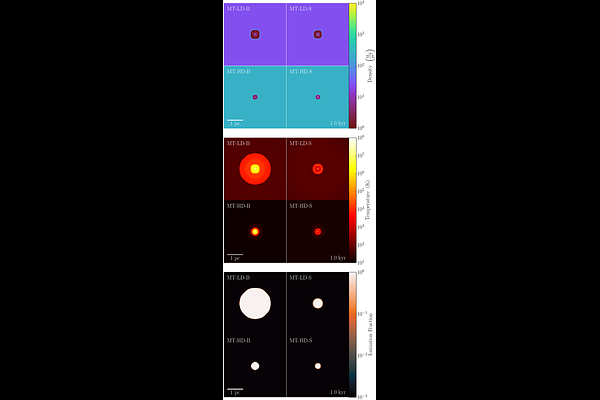Massive Interacting Binaries Enhance Feedback in Star-Forming Regions

Massive Interacting Binaries Enhance Feedback in Star-Forming Regions
Claude Cournoyer-Cloutier, Eric P. Andersson, Sabrina M. Appel, Natalia Lahén, Brooke Polak, Antti Rantala, Silvia Toonen, Alison Sills, Steven Rieder, Simon Portegies Zwart, Mordecai-Mark Mac Low, William E. Harris
AbstractWe present a new framework to incorporate feedback from massive interacting binaries in simulations of star cluster formation. Our new feedback model adds binary stellar evolution to the cluster formation code Torch, and couples it in AMUSE to the pre-existing modules for collisional stellar dynamics, magnetohydrodynamics, and mechanical and radiative feedback. Our model accounts for the effects of mass transfer on the stars' mass loss rates, their radiation spectra, and the timing of core-collapse supernovae. It also injects mass lost through non-conservative mass transfer and common envelope ejection into the interstellar medium. We demonstrate the use of our feedback model through simulations of isolated binaries in a gaseous medium, and of embedded clusters of massive binaries. Feedback from interacting binaries efficiently couples with the surrounding interstellar medium. It increases the size of HII regions, increases the kinetic and thermal energy of the gas, and increases the pressure within HII regions compared to models that use single star stellar evolution. Those differences arise from the ionizing radiation, which increases by three orders of magnitude, resulting in HII regions that expand due to thermal pressure rather than radiation pressure. The effects of stellar dynamics and the gravitational potential of the background gas cause the evolution of individual binaries to deviate from the predictions made by secular evolution, impacting the subsequent feedback from the binary. We conclude that massive interacting binaries are an important source of feedback in cluster-forming regions, and must be considered when studying the emerging timescales of young star clusters.